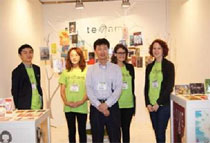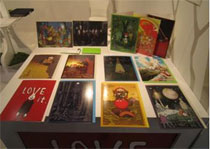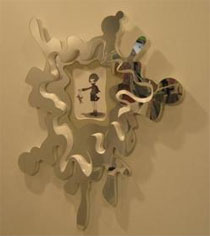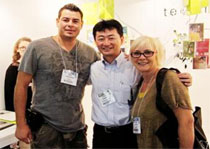Reports and Statistics
Letting the world know - Miyagi Prefecture’s small businesses are on the road to recovery. Konno Printing carves out business opportunities at the New York International Gift Fair.
Sep 8, 2011
Konno Printing (Wakabayashi Ward, Sendai City) is one of the Tohoku region’s leading printing companies. Until recently the company focused on producing goods to order for major firms, but the company has now launched its own independent brand in conjunction with a local Miyagi design office, with a focus on greeting cards. Konno Printing’s main factory was damaged in the Great East Japan Earthquake and the company considered pulling out of its scheduled participation in the New York International Gift Fair. However, it decided to participate in order to tell the world about the recovery efforts of Miyagi Prefecture’s small businesses. Greeting cards with delicately-drawn anime designs attracted a lot of attention at the Gift Fair. JETRO interviewed Mr. Ryuichi Hashiura, president of the company on August 18.
Operations suspended after printing presses thrown off kilter
The tsunami caused by the Great East Japan Earthquake surged to within two kilometers of the site of Konno Printing’s main factory. Among those affected were many of the firm’s friends and customers, including several designers who work in partnership with the company. Konno Printing had to suspend operations at its main factory after its printing presses were thrown off kilter by the shaking. Printing presses are highly-sensitive pieces of equipment and it took around three weeks to get things up and running again. Just as it looked like things were getting back on track though, the presses were thrown off kilter once more by an aftershock on April 7, with the factory having to suspend operations again.
“We were hit hard by having to close the factory during our busiest period at the end of the fiscal year,” says President Hashiura. “This also happened just as we were about to launch a new venture with some of the area’s small businesses. With operations suspended and aftershocks continuing, we did consider pulling out of the New York International Gift Fair on August 14–18 (see note). However, we couldn’t just sit around doing nothing forever. Though we were struggling to get our domestic operations up and running again during this time, we realized that the Gift Fair would be a great opportunity to tell the world about the recovery efforts of Miyagi Prefecture’s small businesses. So in the end we decided to attend in collaboration with a local Miyagi design firm by the name of “Awesome! Create (Representative: Miyuki Shoji).”

President Ryuichi Hashiura (center) and Awesome! Create Representative Miyuki Shoji (second from left) stand at the New York International Gift Fair
Launching an independent brand
Konno Printing (50 employees) is a leading company in the Tohoku area and produces a lot of the region’s New Year cards (Nengajo). Many of the picture nengajo sold in convenience stores throughout the Tohoku region are printed by the company. Konno Printing’s performance in the 103 years since its founding has seen it attract orders from many major companies, as has its policy of always keeping up to date with the latest in printing technology. The company uses state-of-the-art “waterless printing” presses that eliminate harmful waste liquid and help protect the environment. Waterless printing avoids ink blurring and leads to a highly-precise and minutely-detailed final product. The company has used this technique to print a number of high-quality products, including posters, documents and nengajo.
However, the company mainly produces to order for other major firms, so the Konno Printing brand name rarely appears on the products it prints. In addition to contract work, the company also wants to use its printing technology to start some new business ventures. This desire saw the company launch the new, independent “tegami” brand in September 2010 with the help of Awesome! Create’s Miyuki Shoji. The brand will focus on greeting cards and interior goods that use greeting cards.
80% of purchasers are women
According to the US Greeting Card Association (GCA), the domestic US greeting card market is worth more than $7.5 billion a year, with 7 billion cards being exchanged annually. Half this total is accounted for by seasonal cards exchanged on specific occasions such as Christmas or Valentine’s Day. The other half is made up of “everyday cards,” exchanged during regular events such as birthdays or anniversaries. This large-scale exchange of cards on a daily basis is a particular feature of the US market, in contrast to Japan where the majority of cards are of a seasonal nature, exchanged at Christmas or New Year’s, etc.
Prices for greeting cards range from 50 cents to 10 dollars, with a typical card costing around 2 to 4 dollars. Around 80% of all buyers are women, who tend to take their time choosing cards and often purchase several cards at once. Male customers on the other hand usually buy one card at a time.
The independent “tegami” brand is aiming to sell cards at 5 dollars apiece, a little more expensive than average. The target customers are those women in their 20s or 30s who are prepared to take a little time choosing the right card.

Popular greeting cards at the Gift Fair
Targeting fans of Japanese pop culture
The company produced a series of greeting cards to coincide with the International Gift Fair. The theme was “Japanese Pop Culture” and the cards featured cute designs that evoked the fantasy world of Japanese anime whilst also appealing to the adult consumer. The company had already researched card trends beforehand, walking around gift shops in the US, for example, or taking part in the JETRO-organized New York International Gift Fair Mission in February 2011. The pictures on US greeting cards rarely feature detailed designs. Japanese anime is becoming more popular in the US, so by combining anime with its strengths in the area of precision printing technology, the company hoped to attract fans of Japanese pop culture.
“Our most popular cards at the Gift Fair were those that depicted delicately-drawn anime designs. We managed to do business with a number of shops or related distributors who have a customer base of US fans of Japanese pop culture. I think we can be satisfied with the response we got in New York,” says President Hashiura.
Using greeting cards as interior decorations
At the Gift Fair, the company also enclosed the greeting cards in decorative frames and presented them for use as interior goods. The frames were all handmade, with each costing more than 1,000 dollars. Though some buyers were put off by the cost, many more expressed an interest in the products.
The three types of frame on display were all designed and produced by Kinichi Ogata, an interior designer from Miyagi Prefecture who produces his own original furniture and also designs interior spaces for shops and so on. Ogata’s chairs are highly-regarded overseas. At Maison & Objet 2009, an interior design trade fair in Paris, one of them was placed in a display booth close to the fair’s entrance as an example of up-and-coming trends.

The company received many inquiries about these design frames
“By working together with other small businesses in Miyagi Prefecture, we were able to tell the world about Miyagi’s design skills while at the same time concluding several business negotiations. This was a great step forward for us.” says Hashiura.

The company closed deals with many buyers
(Note) Held twice a year, the New York International Gift Fair is North America’s largest specialist trade fair for the lifestyle goods and gifts sector. JETRO’s Japan Pavilion featured design-oriented home/lifestyle goods and gifts from 20 Japanese companies.



